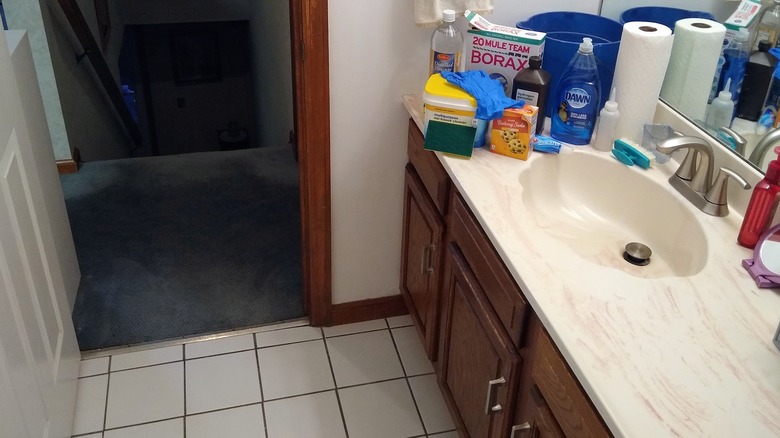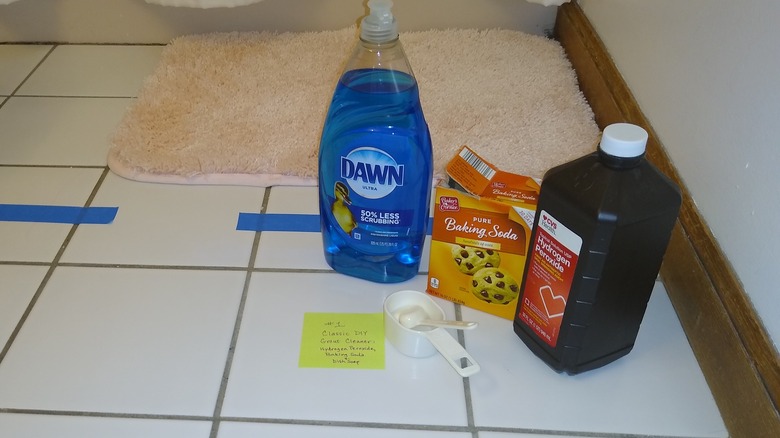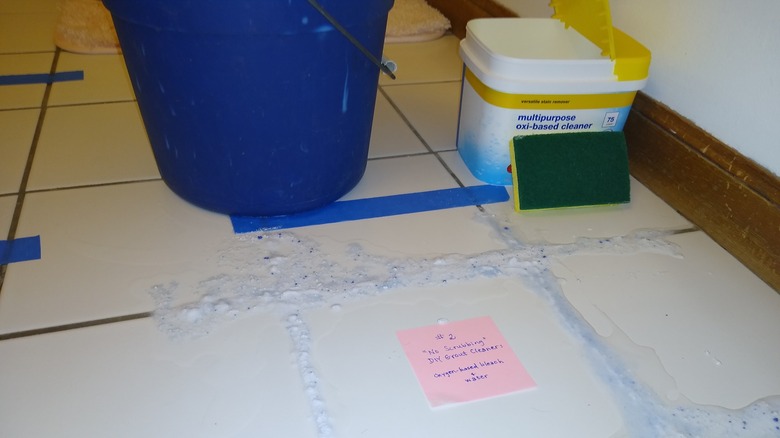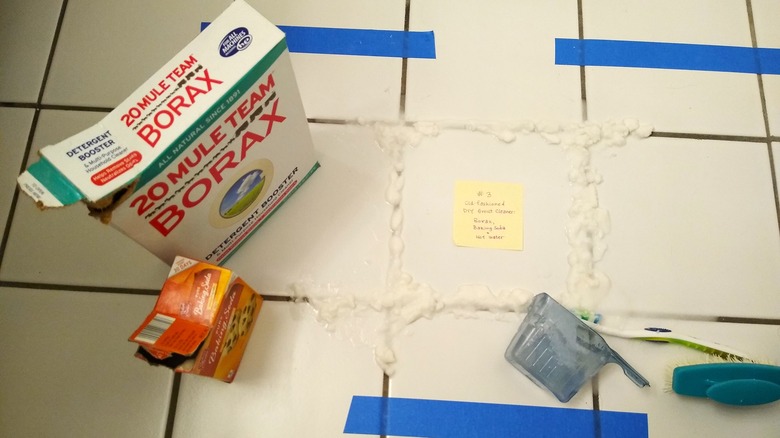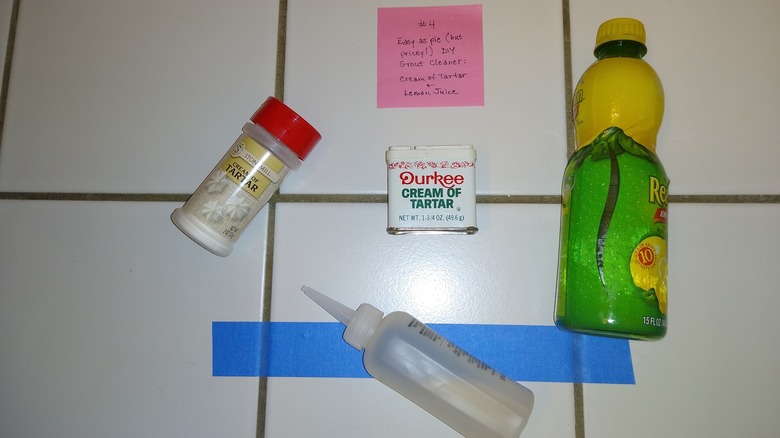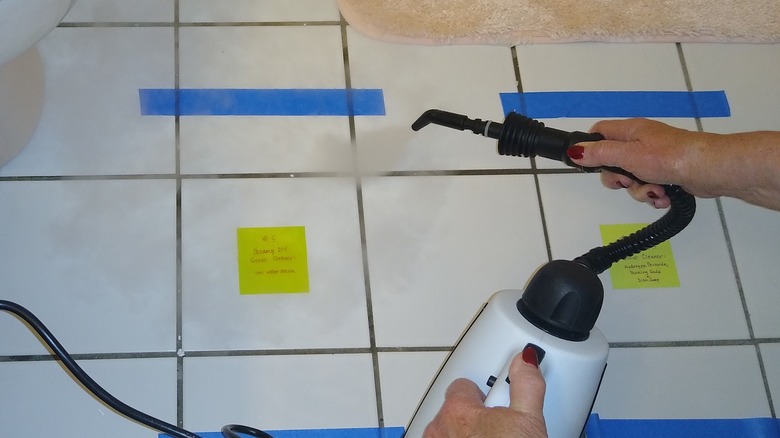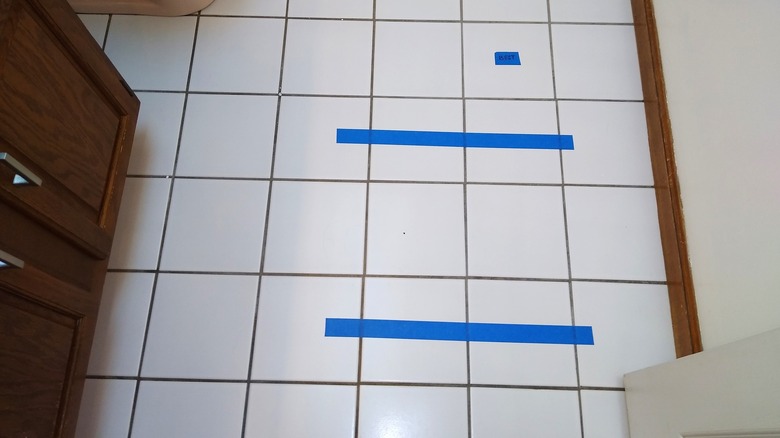We Compared 5 DIY Grout-Cleaning Methods And One Classic Recipe Cut Through The Grime
Sometimes you get used to looking at your floors and don't see how dirty and disgusting the grout between the tiles is. But whether it's visitors arriving for a holiday (clean grout won't make your bathroom guest-friendly for the holidays or any other visit, but it's nice anyway!), or you just noticed the floors look horrible (and now that you noticed them, it's all you can see), you can't put off cleaning the grout any longer. Either way, it's time to get your grout clean and bright.
We could have purchased a product trumpeting claims of grout that's unsoiled, germ-free, and can help your kids with their geometry, but harsh chemicals and shallow promises don't work on people with pets. We feared having to rush our feline to the vet because he decided to test the adage about curiosity and cats or the one about the number of lives they're graced with, so we decided to test multiple ways to clean tile grout using do-it-yourself methods. That doesn't mean we won't have to worry when we break out baking soda and hydrogen peroxide, but they seem better than lists of chemicals we can't pronounce. The bigger question might be which DIY formulas work best and fastest, thus minimizing the amount of time we need to keep our cat out of harm's way? We can close the bathroom door, but after this experiment, the kitchen is next. Finding low-toxic options (for anyone's kids or pets) is a priority.
The classic DIY grout cleaner
The classic DIY grout cleaner that seems to be all over the Internet is one that combines hydrogen peroxide, baking soda, and a popular, grease-cutting, bright blue dish soap. The formula varies slightly from one source to another, but most are fairly close to the one we found when searching how to deep clean your bathroom and keep it clean. Clean grout isn't usually our first thought, but when your grout is grime-free again, you'll wonder how you didn't notice how bad it was.
The formula was easy: ½ cup baking soda, ¼ cup hydrogen peroxide (it didn't specify the percentage; we had 3% on hand, which is a standard dilution), and 1 teaspoon dish soap. The directions said to "spray" the mixture onto the grout, hang tight for a couple of minutes, give it a scrub, then rinse. We understand why spraying was recommended; it was a fairly wet solution, which we had mixed in an old laundry detergent measuring cup. We poured it on the grout of the floor tile, but if you were doing shower wall tile, you'd definitely want to use a spray bottle. We probably waited about 10 minutes because we were gathering materials for the next test, but waiting a little longer didn't seem to hurt anything, and it's possible that it helped the substance do its work a little better. We'd recommend giving it the extra few minutes.
No scrubbing DIY grout cleaner
Do you remember the 1980s song, "Promises, Promises?" That's how we felt with the do-it-yourself formula that is billed as the "no scrubbing" grout cleaner. You made me promises, promises, Grout Cleaner, knowing we'd believe. Lies. All lies.
The "no scrubbing" cleaner seemed very promising. Using oxygen-based, non-chlorine powder bleach and water, the resulting concoction looked good, smelled good, and even bubbled a little as we generously applied it to the grout. One oxygen-based bleach manufacturer, OxiClean, directed users to allow the mixture to stay on the grout for five to 30 minutes. We left it on for about 20 minutes, and as recommended, we tried to keep it from drying out by spritzing it with water from a spray bottle. It dried quickly, and keeping the "no scrubbing" option wet seemed like it defeated the purpose of minimizing the work. True, we didn't have to use any elbow grease, but we had to monitor the grout every three or four minutes for fear it would crumble to dust. In the end, we concur that there was no scrubbing involved, but there seemed to be not much of anything else happening either.
Old-fashioned DIY grout cleaner
It's not boring to use borax, which might make you think of a dusty, old-fashioned box pushed toward the back of your grandmother's laundry area. But your grandmother (or great-grandmother) might remember a time when every household had a box of borax. Its usefulness hasn't changed; it brightens clothes, smothers grease fires, kills marauding insects, and unclogs drains, but these are just a few ways to use borax at home. Even so, these days, borax is probably used more often in making slime for kids to play with than for any other reason, but when it comes to cleaning your tile grout, does this old-fashioned item measure up to its reputation?
Borax is a naturally occurring salt that has been mined and traded since ancient times and used in hundreds of ways over the millennia. The mineral might be natural, but it comes with some cautions. It's similar in some ways to baking soda, but it has a higher pH making it more alkaline. That's great if you're using it to remove acidic stains, but not if you're using it to clean and aren't wearing gloves to protect your hands.
So, does mixing ⅓ cup borax, ½ cup baking soda, and enough hot water to form a paste work as a DIY grout cleaner? The old-fashioned but economical compound made some impact on the grout, but it might have been the scrubbing action after we let it sit for a few minutes that made the difference.
Easy as pie (but pricey) DIY grout cleaner
If you think this do-it-yourself grout cleaner sounds like you have a few of the ingredients for a luscious dessert that reminds you of summertime, you wouldn't be wrong! This isn't the place to come for a lemon meringue pie recipe, but if you're looking for a grout cleaner that uses lemon juice and cream of tartar, then get ready to whip up some DIY cleaning action!
Of all the homemade concoctions we've stirred up, this one is by far the best-smelling of the bunch. Cream of tartar is an acid – the exact opposite of borax — and yet when combined with lemon juice (another acid), will this easy, but rather pricey, DIY grout cleaner do anything? One thing is sure: no noxious fumes resulted from mixing cream of tartar and enough lemon juice (we used the reconstituted kind you can pick up in a grocery store produce section, but you could also go with fresh-squeezed) until it forms a thin paste. Maybe the fresh and bright citrusy scent made us feel smarter, but we poured the blend into an old hair dye bottle and used the applicator tip to help keep the solution pouring out along the grout lines (mostly along the grout lines). It made quick work of the application process. Unfortunately, no matter how good it smelled, it didn't seem to work flawlessly and effortlessly on the grout. It seemed only a little brighter.
Steamy DIY grout cleaner
Hot water steam is the way to clean your grout if you're looking for a totally natural, no-chemical option. You won't have to worry about what the cleaning ingredients in this formula will do to children or pets because nothing has been added; this DIY uses nothing but H2O and the affordable steam cleaner we previously tried on our kitchen floor. It did a good job on the light-colored kitchen grout; would the dark grout in the bathroom be as successful?
Let's start with a few negatives. The first is a precaution. It's HOT. Keep small ones (furry and non-furry) away from the hot steam, and be careful to keep your hands and face protected, too. This isn't the appropriate way to get a facial. Secondly, using a steamer to clean grout can be messy. If you're cleaning the tile in a shower, the excess water just runs down the walls, but when used on the floor, the steamy water will take the path of least resistance; if your floor slopes, that's where the water will go.
On the plus side, in addition to being chemical-free, it's cheap and this do-it-yourself choice has a few other advantages, including the disinfecting properties of steam, and the advantage that as long as you have electricity, you won't run out of cleaning agent midway through the project. As for its cleaning power, there isn't anything hazy about the result: The floor and grout felt cleaner, just not brighter.
The classic DIY grout cleaner wins, but just barely
After all the mixing, squirting, scrubbing, and steaming, we didn't feel as though there was any slam-dunk winner in the do-it-yourself grout-cleaning showdown. There were a few advantages to one method over another in this category or that, but there wasn't a single remarkable standout that we knew would become our go-to method forever.
The classic DIY grout cleaner that used baking soda, hydrogen peroxide, and dish soap, provided the best results. The grout was the brightest after application, but since our grout is dark-colored, it wasn't very noticeable. Perhaps on lighter shades of grout, it would be more obvious.
The "no scrubbing" option that used oxygen-based bleach might have been better with a little scrubbing, and the old-fashioned DIY grout cleaner that used borax didn't do much, even though we hoped an oldie would be a goodie. The easy as pie cleaner that used cream of tartar and lemon juice (like a lemon meringue pie) smelled good, but didn't look very different afterward. And finally, the steamer (the cheapest choice if you already own a steamer) helped marginally, while leaving a lot of condensation behind.
We tried multiple ways and determined the classic DIY grout cleaner, some time, a sturdy scrub brush, and a little muscle work best. Don't forget: Your floor will need a good mopping when you're done.
